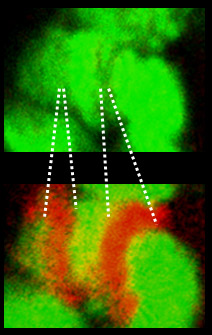Study uncovers how DNA unfolds for transcription
By Krishna Ramanujan

The human genome contains some 3 billion base pairs that are tightly compacted into the nucleus of each cell. If a DNA strand were the thickness of a human hair, the entire human genome would be crammed into a space the size of a softball, but if it were unraveled and all the strands lined up, they would stretch from Ithaca, N.Y., to Boston.
A Cornell study, published in the Jan. 13 issue of Molecular Cell, teases out how cells undergo transcription, where compacted DNA unravels, and a complex enzyme called RNA polymerase II reads the desired gene's DNA base pairs and transcribes them into RNA. The RNA then instructs the cell to make specific proteins based on a gene's blueprint.
In particular, the researchers expand on their previous work that showed that the unraveling of compacted DNA occurs independently of transcription by RNA polymerase II. Many scientists previously believed that RNA polymerase II played a major role in decompacting the DNA.
"The process by which nucleosomes [coiled packets of DNA] become decompacted -- especially during transcription -- hadn't been well characterized until the last decade," said Steven Petesch, the paper's lead author and a graduate student in the lab of John Lis, the paper's senior author and the Barbara McClintock Professor of Molecular Biology and Genetics at Cornell. "If you want to understand how basic processes like transcription occur, then you need to understand the steps that facilitate that process," Petesch added.
To tease out such processes, Petesch and Lis used heat shock genes from fruit flies, which become activated when temperatures rise above a threshold, such as during hot days for fruit flies or when people get fevers. The genes, which are found in many organisms, initiate processes that protect cells from damage. By applying heat, the researchers were able to jump-start within seconds the unfolding of DNA and the transcription of heat shock genes.
When the temperature rises, a protein called a heat shock factor facilitates the steps necessary for transcription to occur. Among other things, Petesch and Lis found that heat shock factor binds to the heat shock genes and activates processes involving key enzymes that ultimately cause the enzyme Poly(ADP-ribose) polymerase (PARP) to locally produce Poly(ADP-Ribose) (PAR), a long polymer similar to DNA and RNA.
When DNA is compacted, strands wrap tightly around proteins called histones, like thread wrapped around a spool, to create packets of nucleosomes. But, it turns out, PAR competes with DNA for binding of histone proteins, which helps them unwrap from their spools and decompact. The researchers found that within seconds of increasing temperatures, heat shock factor is recruited to start the process of modifying histones and the unfolding of the DNA before transcription occurs.
"This process is completely independent of RNA polymerase II transcribing through the gene," said Petesch. Lis added, "However, this process is completely dependent on heat shock factor and PARP's ability to make PAR chains, which are necessary to rapidly remove nucleosomes and unravel the induced gene."
PARP has been known for decades as important for DNA repair and is targeted in some cancer treatments.
The research was funded by the National Institutes of Health.
Media Contact
Get Cornell news delivered right to your inbox.
Subscribe